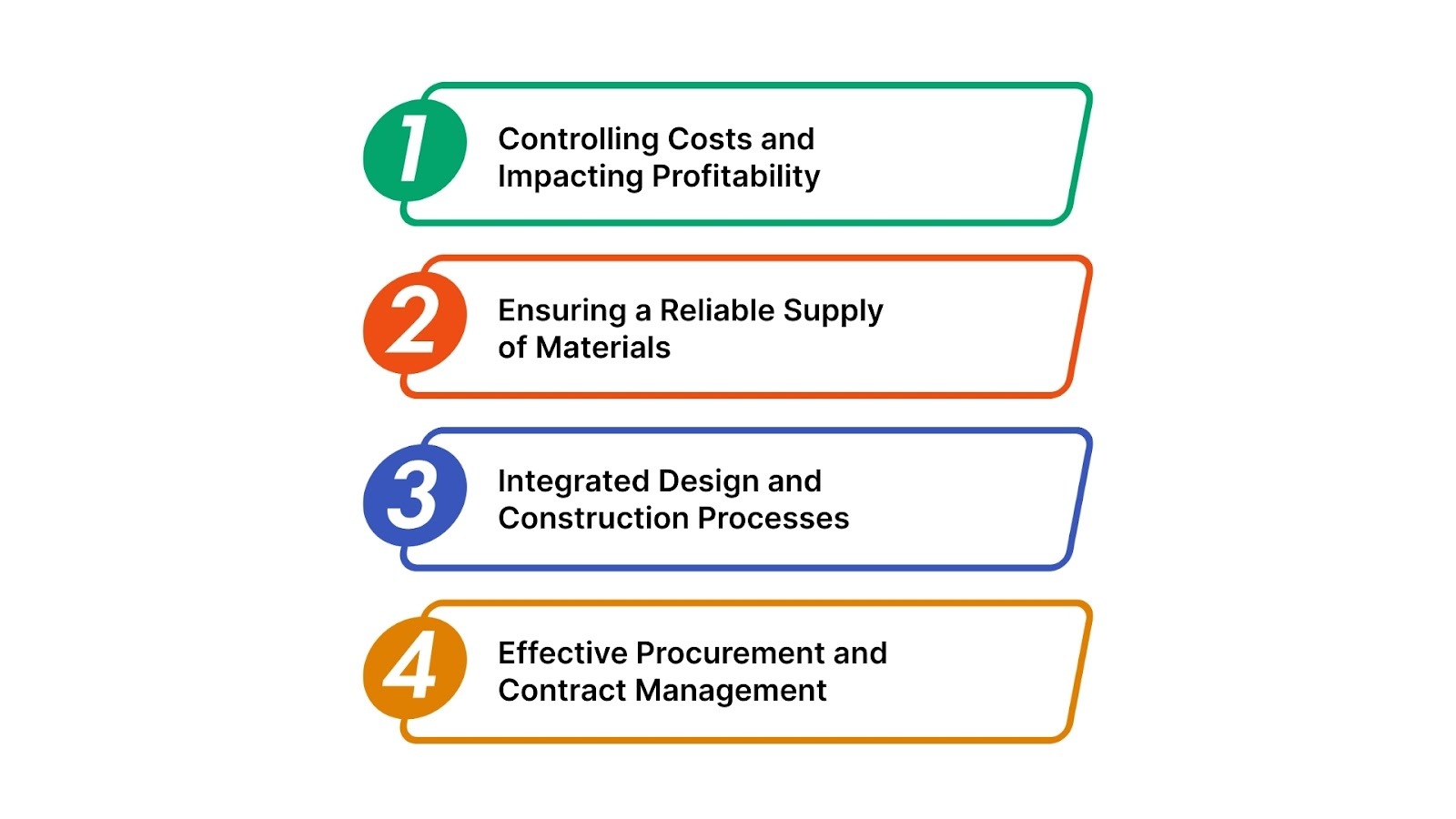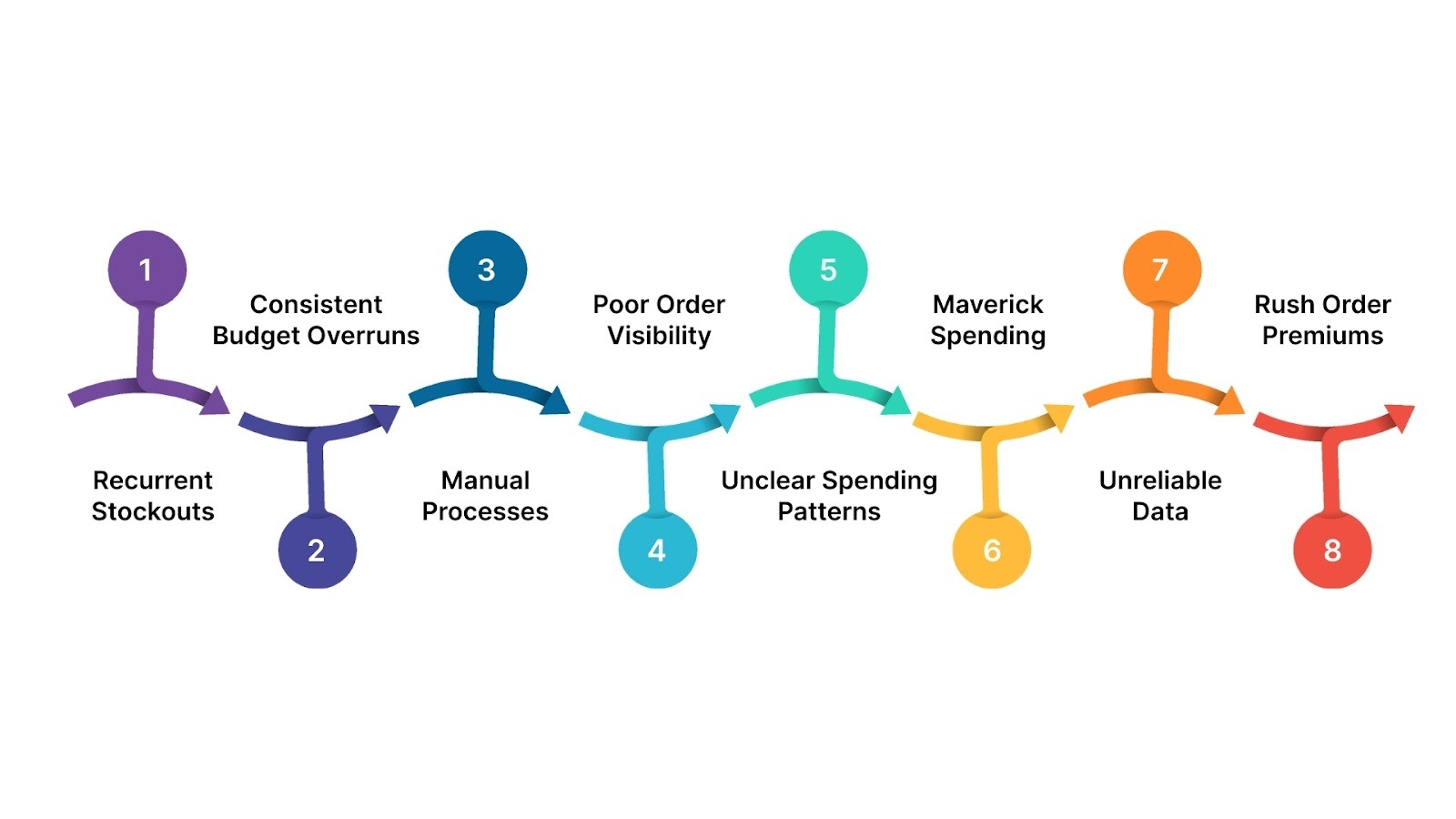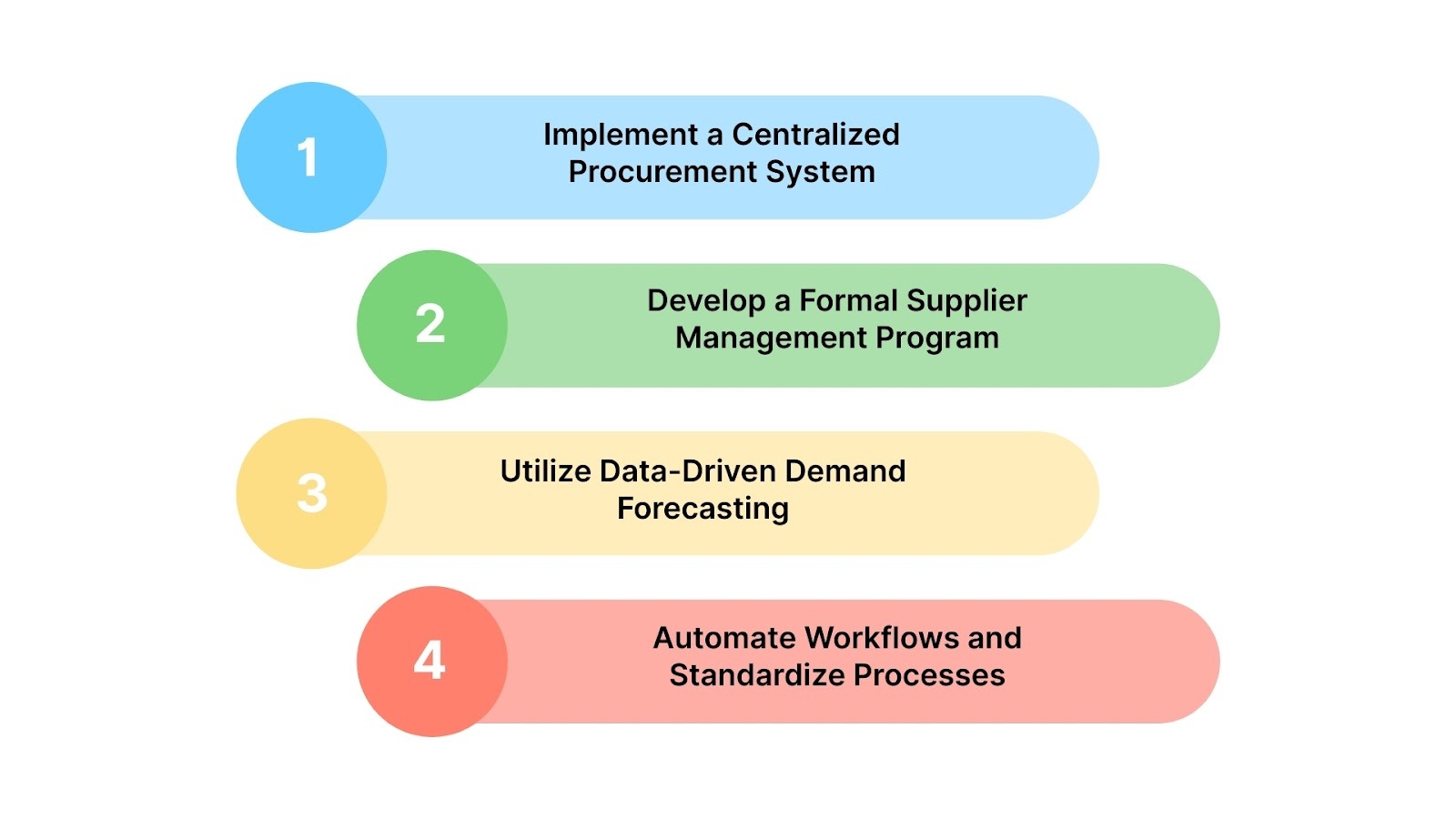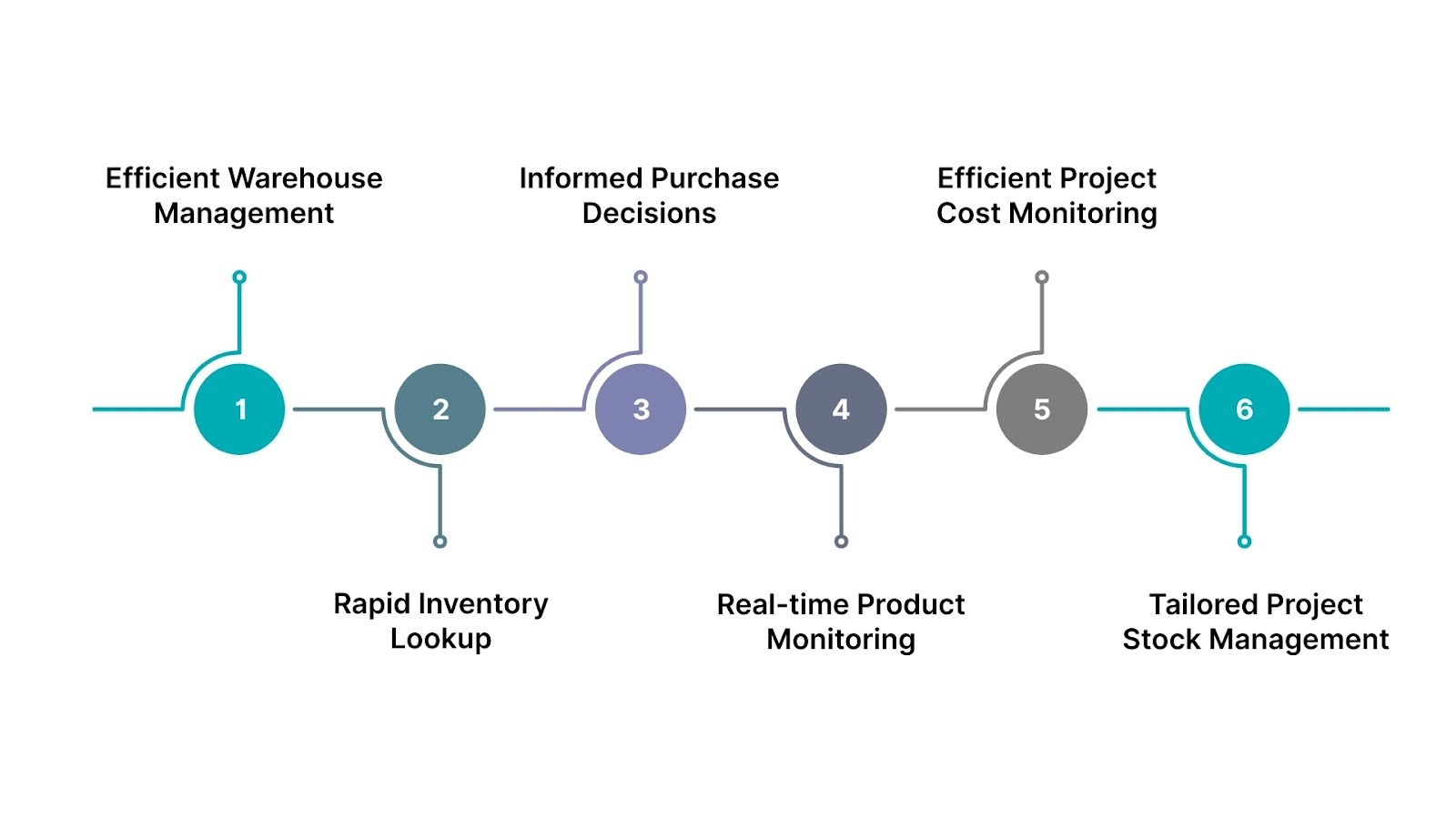
Procurement is more than just purchasing; it's a critical strategic function that directly impacts your company's efficiency, compliance, and bottom line. In Saudi Arabia, Vision 2030 procurement requirements are driving large-scale infrastructure investments and privatization.
This places procurement management in Saudi Arabia under greater pressure than ever to deliver transparency, cost control, and agility. For example, a contractor might face penalties for delayed projects because they couldn't track materials across multiple sites, or a retailer might lose sales during Eid because popular items were out of stock.
For growing businesses, manual processes and disconnected systems can turn this vital function into a source of major operational delays and financial risk, hindering your ability to capitalize on new opportunities.
This blog will outline the most common procurement challenges you might be facing and provide clear, actionable solutions. You will learn how a strategic approach to procurement, supported by the right technology, can transform this function from an administrative task into a key driver for growth and stability.

Procurement is the strategic process of sourcing and acquiring the goods and services your business needs to operate, from raw materials and office supplies to software and professional services. It encompasses everything from identifying suppliers and negotiating contracts to managing orders and ensuring timely delivery.
For your business, a well-managed procurement process is more than just a behind-the-scenes function; it's a crucial part of achieving operational success and financial health. Its importance is clear in these key areas:
Effective procurement directly affects your bottom line. By negotiating favorable terms with suppliers and avoiding rushed, expensive purchases, you can significantly reduce your operational expenses and protect your profit margins.
Your production and sales depend on having the right materials available when you need them. A structured procurement process minimizes the risk of supply chain disruptions that can halt your operations and lead to lost revenue.
Procurement ensures that the goods and services you acquire meet your specific quality requirements and adhere to relevant regulations, such as local VAT reporting standards. This protects your brand reputation and avoids potential legal or financial penalties.
Moving beyond simple transactions, procurement allows you to develop long-term partnerships with key suppliers. These relationships can lead to better pricing, priority service, and collaborative innovation, giving you a competitive advantage.
Understanding procurement's strategic role makes it easier to identify when this function is underperforming. Here are some early warning signs that your current process may need attention.

Inefficient procurement management often starts with subtle issues that can escalate into significant operational and financial problems. Many businesses overlook these early indicators, attributing them to normal growing pains.
However, recognizing these signs is the first step toward implementing a more strategic and controlled process. If your business is experiencing several of the following symptoms, it may be a signal that your procurement function requires immediate attention.
These operational inefficiencies are especially critical now, as national economic transformation is raising the stakes for procurement excellence.
Also read: Understanding the Role of ERP in Supply Chain Management
Vision 2030 procurement requirements elevate procurement from a back-office function to a strategic priority. It demands greater transparency, local supplier development, and digital transformation from businesses.
Your procurement management strategy in Saudi Arabia must now support national goals for economic diversification and efficiency.
Adopting these modern practices is crucial for your company's growth and compliance. It ensures you align with the kingdom's ambitious economic and regulatory framework.
Aligning with these strategic goals requires first overcoming the fundamental challenges that hinder procurement performance.

Effective procurement management in Saudi Arabia is a complex balancing act that involves managing costs, relationships, and risks simultaneously. For growing businesses in the Kingdom, several deep-rooted procurement challenges can prevent this function from operating as the strategic asset it should be.
These issues often stem from outdated processes and a lack of integrated visibility. Understanding these core problems is essential to addressing them. Here are some common procurement challenges you may be facing:
Without a centralized system, purchasing happens across departments with no unified oversight. This makes it nearly impossible to analyze total spending, identify cost-saving opportunities, or enforce negotiated supplier contracts, leading to missed discounts and maverick spending.
Managing multiple suppliers effectively is difficult without structured performance tracking. This can result in inconsistent quality, unreliable delivery times, and a lack of leverage in negotiations, preventing you from building strategic partnerships that offer better value.
Poor visibility into inventory levels and sales data leads to incorrect forecasts. The result is either overstocking, which ties up working capital in unused inventory, or understocking, which causes production delays and lost sales opportunities.
Manually ensuring ZATCA compliance for every purchase order and invoice is a complex and error-prone task. This exposes your business to the risk of financial penalties during audits.
Global and local events can disrupt supply chains unexpectedly. Without a proactive risk management strategy, your business is vulnerable to shortages, price volatility, and logistical delays that can halt operations and impact customer commitments.
When your procurement data is trapped in separate systems from finance, inventory, and operations, it creates a fragmented view. This disconnect prevents strategic analysis and forces teams to waste time reconciling data instead of acting on insights.
When preoccupied with day-to-day transactional issues, your procurement team cannot focus on strategic activities like analyzing spend patterns, qualifying new suppliers, or negotiating volume-based discounts that substantially lower costs.
These challenges are interconnected, often rooted in using disconnected systems that cannot provide a unified view of your operations. Overcoming them requires a centralized approach that turns procurement data into a strategic asset. HAL ERP provides the integrated platform you need to gain control. Book a Free Consultation.
Imagine a construction company working on a Vision 2030 project. With HAL ERP, they can ensure steel and cement are delivered exactly when needed to avoid site delays, automatically generate ZATCA-compliant invoices for all material purchases, and track costs in real-time to prevent budget overruns. This is the level of control and compliance modern Saudi business requires.
While these challenges are significant, they are not insurmountable. Addressing them requires a shift to proactive strategies built on integration and data.
Also read: Understanding the Importance and Benefits of ERP Systems for Enterprises

Addressing procurement challenges requires a move from reactive, transactional purchasing to a proactive, strategic approach. This shift is supported by integrating technology, data, and clear processes to create a procurement function that drives value, manages risk, and supports broader business objectives.
Consider these four strategies to strengthen your procurement management:
Adopting a unified platform provides complete visibility into all spending across departments. This allows you to consolidate purchases, enforce compliance with approved suppliers and budgets, and use data from company-wide spending to negotiate better contracts and payment terms, directly addressing maverick spending and lack of control.
Move beyond viewing suppliers as mere vendors by establishing a program that categorizes them based on strategic importance and performance. Develop clear key performance indicators (KPIs) for on-time delivery, quality, and cost.
This enables you to nurture relationships with critical partners, conduct regular performance reviews, and mitigate risk by qualifying alternative suppliers.
Integrate your procurement data with sales, inventory, and production planning systems. By studying past data and current trends, you can develop more precise predictions for material requirements.
This prevents both excess inventory and stockouts, ensuring capital is not tied up unnecessarily while also maintaining production continuity.
Map out and standardize your procurement lifecycle, from requisition to payment. Then, use technology to automate approval workflows, purchase order generation, and the matching of orders with received goods and invoices.
This significantly reduces processing times, minimizes manual errors, and frees your team to focus on strategic tasks rather than administrative duties.

Implementing these strategies effectively depends on having the right technological foundation. This is where a unified ERP system becomes a strategic advantage.
Also read: Best ERP Inventory Management Software 2025

HAL ERP directly addresses the core procurement challenges by providing a unified platform. For businesses seeking strong ERP solutions in KSA, our system is built to support the specific needs of the Saudi market, including automated ZATCA compliance procurement.
Beyond operational control, HAL ERP embeds critical compliance directly into your procurement workflow. The system automatically handles ZATCA compliance procurement, generating compliant e-invoices and maintaining the complete audit trail.
This brings your inventory, purchasing, and project stock management into a single, integrated system. Which eliminates data silos and manual processes, giving you real-time visibility and control over your entire supply chain to reduce costs, prevent stockouts, and maintain compliance. It transforms procurement from an administrative task into a data-driven strategic function.
Key features include:
Beyond operational control, HAL ERP embeds critical compliance directly into your procurement workflow. The system automatically generates ZATCA-compliant e-invoices and maintains the complete audit trail required for tax reporting.
This automation is built to align with SOCPA accounting standards, ensuring your financial reporting meets local statutory requirements. By managing compliance within the same unified system, you significantly reduce manual effort, eliminate common errors, and lower your audit risk.
Jash Holding, a major facilities management and contracting group, faced inefficiencies from scattered project data and manual payroll for 4,000+ employees. They implemented HAL ERP to centralize financial workflows, automate payroll, and track project costs and inventory with precision.
The result was a 60% gain in operational efficiency, a major reduction in manual data entry, and significantly improved profitability insights and cross-subsidiary coordination, enabling faster, more informed decision-making across the entire organization.
Ready to achieve similar results? Start reducing your procurement costs by 40% and unlock 60% operational gains. Schedule your free demo today.
Also read: Unleash Efficiency and Savings with Strategic Procurement
Manual procurement processes and disconnected systems create costly delays, compliance risks, and a lack of control over spending. HAL addresses these challenges directly by integrating your inventory, purchasing, and project management into a single, automated platform.
This provides the real-time visibility and data-driven insights you need to reduce costs, ensure material availability, and maintain complete regulatory compliance.
Ready to transform your procurement process? Get a free HAL ERP demo customized for your Saudi business - Book your consultation today.

Q: What is the biggest procurement challenge?
The lack of spend visibility from using disconnected systems. This makes it impossible to track total spending, enforce contracts, or control costs, leading to budget overruns.
Q: How long does HAL ERP implementation take for a typical Saudi business?
A basic setup and training takes 2-4 weeks, while a full implementation with data migration and customization typically takes 8-12 weeks. Our dedicated teams in Saudi Arabia ensure a smooth transition with minimal disruption to your operations.
Q: What is the ROI timeline for HAL ERP in procurement?
Many of our clients see a positive return on investment within the first year. This comes from reducing manual errors, automating ZATCA compliance, and achieving better pricing through improved spend visibility and supplier negotiations. For example, our case studies show clients achieving a full ROI in under 12 months.
Q: Does HAL ERP support the Arabic language and Saudi business practices?
Yes, absolutely. HAL ERP offers full bilingual support in Arabic and English. It is built for the Saudi market, with features for ZATCA e-invoicing, VAT reporting, and alignment with SOCPA accounting standards, ensuring it fits local business workflows seamlessly.
Q: How does HAL ERP compare to other ERP solutions in the KSA market?
While other solutions offer generic features, HAL ERP is built with deep local expertise. We provide region-specific compliance tools, dedicated local support, and industry-specific modules for sectors like contracting and retail that are pre-configured for Saudi regulations, unlike international systems that require heavy customization.
Q: How does HAL ERP ensure local tax compliance?
HAL ERP automatically generates ZATCA-compliant e-invoices and maintains the complete audit trail required for tax reporting. This automation is built to align with SOCPA standards, significantly reducing manual effort and audit risk.
